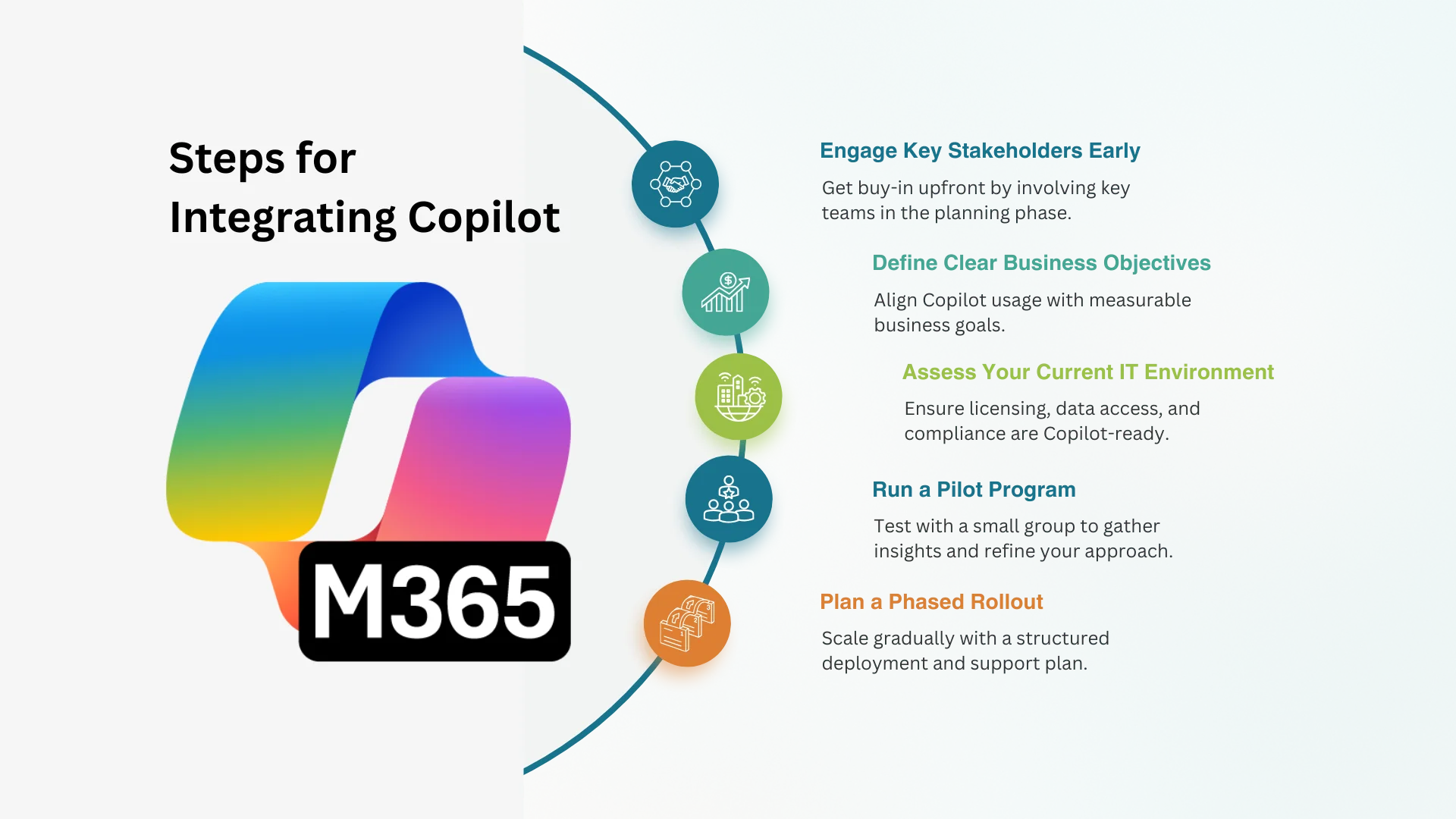- TIPS & TRICKS/
- Deploying Copilot Effectively: A Guide for IT Managers on Integration, Training, and Change Management/


Deploying Copilot Effectively: A Guide for IT Managers on Integration, Training, and Change Management
- TIPS & TRICKS/
- Deploying Copilot Effectively: A Guide for IT Managers on Integration, Training, and Change Management/
Deploying Copilot Effectively: A Guide for IT Managers on Integration, Training, and Change Management
Deploying Copilot effectively is another change that IT managers must manage carefully. It involves strategic integration, comprehensive user training, and thoughtful change management.
Copilot is considered a foremost mover in AI productivity tools, with over 60% of Fortune 500 companies adopting it. IT managers are now tasked with overseeing Copilot integration to ensure their organisation fully realises the productivity benefits within Microsoft 365 (M365).
This guide delivers a practical roadmap for weaving Copilot into your M365 environment, anticipating the real-world challenges users will meet, and using targeted training to turn curiosity into productive use.
Understanding the Role of Copilot in the M365 Environment
Microsoft Copilot is an AI-powered assistant designed to simplify operations, automate tasks, and augment human productivity within the Microsoft tools.
Its integration with Microsoft 365 enhances the overall user experience. By connecting with applications such as Excel, Outlook, and Teams, Copilot becomes a natural extension of daily workflows—accessible directly within each app.
- Word: assist with drafting and refining texts;
- Excel: supports data analysis and generating insights
- PowerPoint: helps design and structure presentations
- Outlook: summarise email threads for quicker understanding
- Teams: generates meeting notes and reports.
This functionality enables users to complete tasks faster and more accurately. Copilot's AI-driven recommendations can anticipate user needs, improving workflow efficiency.
Because Copilot relies heavily on Microsoft Graph and existing M365 data permissions, successful integration requires careful alignment with IT architecture, governance policies, and user readiness.
A Practical Framework for Integrating Copilot Into Your M365 Environment
Successful integration of Copilot requires more than just flipping a switch; it demands strategic planning, collaboration, and change management. This framework provides IT managers with a step-by-step roadmap to ensure smooth adoption and long-term impact.

1. Engage Key Stakeholders Early
Start by involving key stakeholders, from department heads to end-users. Their input helps shape a rollout that reflects real workflows and uncovers potential roadblocks before they arise. Early engagement also builds buy-in and ensures that expectations are set across the business.
2. Define Clear Business Objectives
You can only measure the effectiveness of Copilot when it's aligned with clear business goals. Define what success looks like for your organisation in measurable terms, whether that’s faster data analysis in Excel, quicker insight generation, or reduced time spent on repetitive tasks. This gives you a solid benchmark to assess Copilot’s real impact and ensure it’s driving meaningful results.
3. Assess Your Current IT Environment
Before deployment, review your Microsoft 365 licensing to ensure your organisation qualifies for Copilot. Then audit your data governance framework, access controls, and compliance settings. These factors shape the quality of Copilot’s responses and your ability to roll it out securely and at scale.
4. Run a Pilot Program
Instead of going all-in from the start, launch Copilot with a small, cross-functional pilot team. This group serves as your early test case, surfacing practical feedback, uncovering usability issues, and helping fine-tune internal guidance and support resources before wider adoption.
5. Plan a Phased Rollout
With lessons from the pilot in hand, develop a phased rollout strategy. This plan should include key milestones, training checkpoints, and resource allocation. Staggering the deployment by team or function allows for better support and troubleshooting as usage ramps up across the organisation.
Training Strategies That Empower Copilot Users
Effective training is not just about getting users to adopt Copilot, but also about maximising its full capacity.
1. Structured Training
General training is good, but a tailored training program will yield better results. IT managers must ensure that every stakeholder receives structured training based on their usual tasks and tools. Copilot is maximised when users know how to effectively prompt it, interpret its outputs, and apply the results to their workflows.
2. Develop Practical Training Materials
Create role-specific training resources highlighting the most relevant Copilot features to their tasks. Supplement these resources with quick-start templates, an internal knowledge base, an FAQ section, step-by-step guides, cheat sheets, and short video tutorials to encourage continuous learning.
3. Hands-On Sessions and Live Demonstrations
The best form of learning is doing. IT managers should complement theoretical training with hands-on interactive workshops and short webinars tailored to every department’s needs. Encourage presentations from team members and collect feedback to further tailor the training to observed realities.
Addressing Copilot User Challenges
Several challenges will emerge as users interact with Copilot within the M365 environment. IT managers should identify these challenges and providing solutions.
Common Challenges:
- Understanding the type of prompts that give the best results.
- Misunderstanding how the AI assistant works.
- Over-relying on the AI’s output without validating it.
- Interpreting Copilot’s output.
- Hesitation about using a new AI tool, and so on.
Solutions:
- Explain Copilot’s data sources and limitations from the get-go.
- Reinforce the infallibility of Copilot despite its intelligence. Encourage users to double-check outputs.
- Provide clear guidance on prompt engineering.
- Offer an exhaustive list of good and bad prompts.
- Encourage experimentation and learning.
- Reinforce that Copilot is just an assistant, not their replacement.
When the integration process begins, more challenges will surface. The important thing is for IT managers to be proactive in solving every challenge that arises.
The final solution block will be to build a support system for the users. Establish clear communication channels for users seeking help. Examples could be an internal knowledge base or designated “Copilot champions” within different departments that can assist their colleagues.
Navigating IT Concerns During Deployment
Deploying Copilot brings several IT concerns. Proactively addressing these ensures smooth integration. It's vital to focus on security, performance, and continuous improvement.
Security and Compliance
We touched on this earlier, but it is worth reiterating. Security is a non-negotiable when deploying AI solutions. IT will need to ensure the use of Copilot complies with relevant regulations and security frameworks.
This often includes understanding data residency, ensuring that conditional access policies limit Copilot’s exposure to high-risk scenarios, and any potential risks. Regular review of security settings and access controls is necessary.
Performance Monitoring and Troubleshooting
Once Copilot is deployed, having tools and processes for monitoring and troubleshooting will be essential. You can leverage tools in the Microsoft Admin Centre to see how different departments are utilising the AI assistant. Monitoring ensures that nothing goes unnoticed and every issue is attended to promptly.
Continuous Improvement
IT is still very much involved after deployment. Ensure to gather feedback from support teams and users continuously. This will help in adjusting the training materials and configurations. Regularly check in with stakeholders to ensure Copilot remains a valuable asset with evolving business needs.
Best Practices For Change Management
Successfully introducing Copilot is more about the people than the technology. Change management ensures your teams are informed, prepared, and supported throughout the transition. Here are key practices to help drive adoption and reduce resistance.
Transparent Communication
Trust is built on transparency. Ensure you communicate risks as much as benefits. Share the rationale for adopting Copilot with every stakeholder. Carry everyone along as much as possible. Provide constant updates throughout the integration process to keep users informed.
Manage Expectations
Unmanaged expectations lead to disappointment and frustration. Generative AI is still an evolving industry. Users need a clear understanding of what Copilot can and can’t do, including the possibility of occasional inaccuracies. Setting realistic expectations helps users adopt the tool with a balanced mindset, ready to learn and adapt.
Evaluate and Adapt
Regular pulse surveys and feedback sessions are great ways to adapt Copilot integration to business needs continuously. Flexibility is a necessity from the outset. IT managers must be ready to adjust training programs, feature access, and integration plans based on feedback.
Making Copilot Work for Your Organisation
Deploying Copilot effectively goes deeper than introducing a new tool to your workflow. It reimagines how teams work, opens new possibilities, and empowers organisations to achieve more.
Therefore, by applying the right integration strategy, structured training, and thoughtful change management, IT managers can lead a transformation that boosts productivity and unlocks innovation across the business.
The next step for any IT manager considering Copilot should include thoroughly assessing their current M365 environment, identifying top departments that will benefit from it, defining clear objectives, engaging key stakeholders, and planning a pilot program and feedback loop.
Make sure to check our instructor-led Copilot training courses, which are suitable for both beginners and advanced users!
Related Articles
 L&D Insights
L&D InsightsLiteracy vs Digital Literacy: What Are the Differences?
Traditional reading-and-writing literacy has broadened into digital literacy—the ability to locate, evaluate, create, and communicate information safely and effectively through technology. The article traces this evolution from basic “computer literacy” of the 1990s to today’s multifaceted concept that spans information, media, and AI literacy. Digital skills now underpin social inclusion, workforce readiness, and democratic participation, while gaps in access, competence, and support exacerbate inequality.
 Tips & Tricks
Tips & TricksCopilot vs. ChatGPT vs. Gemini: How to Choose the Right AI Assistant for Your Task
Microsoft Copilot, OpenAI’s ChatGPT, and Google’s Gemini are leading AI assistants, each excelling in different environments. Copilot integrates deeply with Microsoft 365 to automate documents, data analysis, and email, while ChatGPT shines in open-ended conversation, creative writing, and flexible plugin-driven workflows. Gemini prioritises speed and factual accuracy within Google Workspace, offering powerful research and summarisation capabilities. Choosing the right tool depends on your ecosystem, need for customisation, and whether productivity, creativity, or precision is the top priority.
